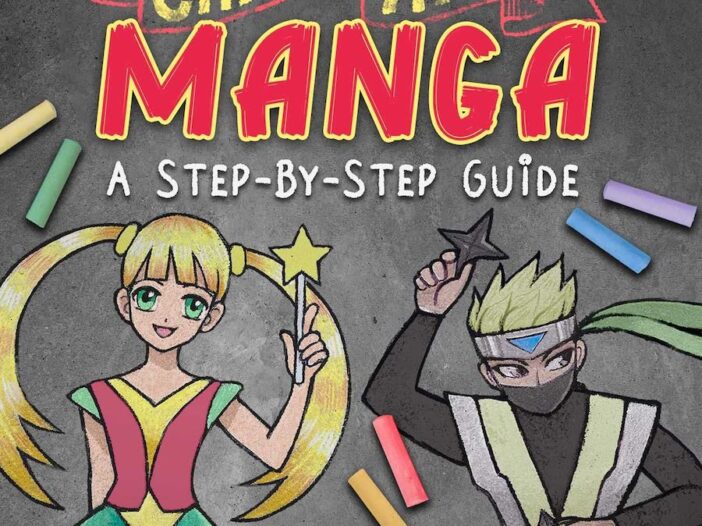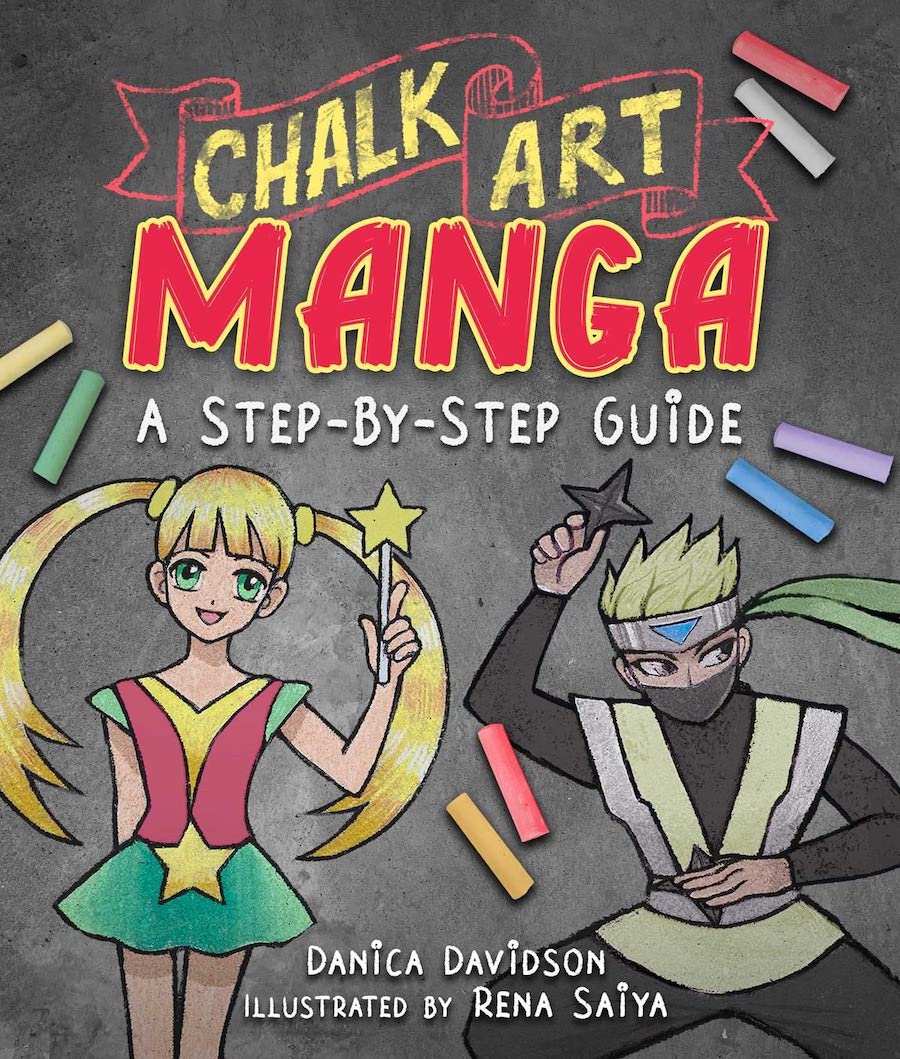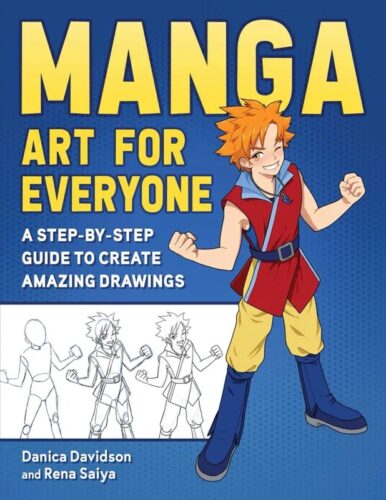
Danica Davidson on ‘Chalk Art Manga’ | Interview

Danica Davidson’s Chalk Art Manga does just what it says on the cover: Davidson worked with Japanese artist Rena Saiya to come up with step-by-step instructions for a series of manga-style drawings done in chalk. This is Davidson’s third how-to-draw-manga book; her first was Manga Art for Beginners, and her second is Manga Art for Everyone (formerly titled Manga Art for Intermediates). Davidson is a regular writer for Otaku USA and the author of numerous books, from Minecraft novels to the recently published book I Will Protect You: A True Story of Twins Who Survived Auschwitz, which she co-wrote with Holocaust survivor Eva Mozes Kor.
Chalk Art Manga was published by Skyhorse in June. We talked to Davidson about how she came up with the idea, and what it’s like to collaborate with a real manga artist from Japan.
ADVERTISEMENT
ADVERTISEMENT
What gave you the idea to do this particular version of a manga book.
An editor at Skyhorse actually came up with the idea and approached me, and as soon as I heard the idea of doing manga and chalk art, I thought, why has no one done this before? I thought it sounded really fun. Like a lot of Americans. I grew up doing chalk art, and it’s great to combine my love of manga with the fun of drawing with chalk.
So what did you do next? Did you grab some chalk and go out and do some drawings?
I did! And I also hooked up with Rena Saiya, who was the artist I worked with for this book. She’s also the artist I worked with for Manga Art for Everyone. In Japan, they have chalk art, but it tends to be more on chalkboards, so she thought it was really interesting how in America, we do it in our driveways and sidewalks. I mailed her chalk from America, to make sure she had the same chalk we’re using, and she started drawing on her own, and we worked together. I came up with characters I thought would be really good for this. I wanted to get really colorful, because of the ability to do that with chalk. A lot of manga is black and white, but with chalk, you can have all sorts of colorful candy. It ends with a Harajuku girl because I thought this was a perfect way to show Harajuku fashion and all of its vibrancy.
I wanted to make this book so that it had a range of art skills in it, so the beginning of the book has the easiest drawings, and anyone ought to be able to do that. The candy and the sushi, whatever age, whatever art background, here’s stuff you can do. Then it builds its way up to more complex drawings. So you can start at the beginning and work your way up and use it to learn more. Or if you’re already skilled at art, it just puts it out for you on how you get these certain looks.
How did you work with Rena?
I say to her what I want, and she experiments and sends me her preliminary draft to see if I like it. I love working with Rena because I basically always like her preliminary suggestions. And then we would go back and forth. Because of the 13-hour time difference, we would Skype to discuss it in the night time for me, morning for her. I sent her lots of stuff about chalk in America so she’d have an idea of what’s going on, and she studied chalk by herself. Then she would send me the drawings back step by step, just taking pictures as she went with her phone, and I would do all the writing and describe it step by step. I wanted to make sure it really showed all the steps, because there are so many art books that are like five steps and you’re done. You really need more than that.
ADVERTISEMENT
ADVERTISEMENT
I thought of what characters would be really good for this type of thing that’s also of interest to manga fans, and I also put in some that I think are fun for kids in general. There’s a T Rex and there’s a unicorn, but of course both of those appear in manga sometimes.
What makes these manga drawings as opposed to any other kinds of drawings?
They are in the manga style. Rena is a manga artist. She’s a professional in Japan. She’s published quite a bit over there, but she uses a different name to keep the work separate. And as you can see with the T Rex that is not what a T Rex would have looked like in real life. Its proportions are exaggerated. That’s keeping with the manga style.
How did you meet Rena?
On LinkedIn. I had been wanting to work with an actual manga artist. I found her there and she had a note that she spoke English and she wanted to publish abroad, so I reached out to her.

Tell me about Manga Art for Everyone.
The first book we did together was Manga Art for Intermediates. I was uncertain about the title when it first came out because I thought it might sound too intimidating to people, which does seem to be the case because Manga Art for Beginners, which is the first book I did, is selling really well. So we are coming out with it with a new title, Manga Art for Everyone, and new cover art, but it is the same book on the inside. It still shows the steps in great detail, and in more detail than any other manga art book I’ve seen. The only real difference is that at the beginning of Manga Art for Beginners, we show anatomy drawings, we show how to do eyes and faces and figures, because it’s for beginners. In Manga Art for Everyone, we don’t show the basic anatomy stuff, but we do show how manga is made in Japan. We show how to make hair shiny, how to put screen tones on, what pens they use over there, what software they use over there. It opens with that and then it gets into the character drawings with the same level of steps and detail as Manga Art for Beginners. Of course, if you’re doing your own art, you don’t have to use these pens, you don’t have to use the software, but if you want to, it’s in there.
Filed under: Interviews, Manga
About Brigid Alverson
Brigid Alverson, the editor of the Good Comics for Kids blog, has been reading comics since she was 4. She has an MFA in printmaking and has worked as a book editor, a newspaper reporter, and assistant to the mayor of a small city. In addition to editing GC4K, she is a regular columnist for SLJ, a contributing editor at ICv2, an editor at Smash Pages, and a writer for Publishers Weekly. Brigid is married to a physicist and has two daughters. She was a judge for the 2012 Eisner Awards.
ADVERTISEMENT
ADVERTISEMENT
SLJ Blog Network
Should I make it holographic? Let’s make it holographic: a JUST ONE WAVE preorder gift for you
Press Release Fun: Happy Inaugural We Need Diverse Books Day!
Fifteen early Mock Newbery 2026 Contenders
When Book Bans are a Form of Discrimination, What is the Path to Justice?
RA Tool of the Week: Inside Out Inspired Emotions, but Make it YA Books
ADVERTISEMENT







